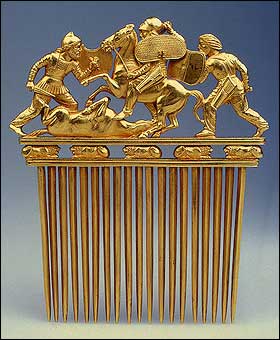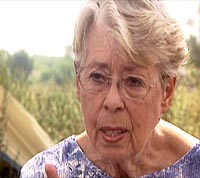


Notice: This is the official website of the All Empires History Community (Reg. 10 Feb 2002)
|
Post Reply 
|
Page 123 4> |
| Author | ||||
kotumeyil 
Chieftain 
Retired AE Moderator Joined: 21-Jun-2005 Location: Turkey Online Status: Offline Posts: 1494 |
 Topic: Scythians Topic: ScythiansPosted: 13-Dec-2005 at 18:38 |
|||
|
OK friends. I'm gonna lock the thread now. If you really think that you can add something different than the total 13 pages about Scythians, PM me so I'll unlock it. If not, there are many other subjects about Steppes...

|
||||
|
[IMG]http://www.maksimum.com/yemeicme/images/haber/raki.jpg">
|
||||
 |
||||
kotumeyil 
Chieftain 
Retired AE Moderator Joined: 21-Jun-2005 Location: Turkey Online Status: Offline Posts: 1494 |
 Posted: 13-Dec-2005 at 18:09 Posted: 13-Dec-2005 at 18:09 |
|||
|
If you have any contribution other than "They are Turks!" or "No, they are Persians!" of course you can write. But hurry up, time's marching on

|
||||
|
[IMG]http://www.maksimum.com/yemeicme/images/haber/raki.jpg">
|
||||
 |
||||
Guests 
Guest 
|
 Posted: 13-Dec-2005 at 17:14 Posted: 13-Dec-2005 at 17:14 |
|||
|
is time up? can we write now? |
||||
 |
||||
kotumeyil 
Chieftain 
Retired AE Moderator Joined: 21-Jun-2005 Location: Turkey Online Status: Offline Posts: 1494 |
 Posted: 12-Dec-2005 at 17:44 Posted: 12-Dec-2005 at 17:44 |
|||
|
Enough about the Persian or Turkic character of Scythians. If no contribution other than this issue comes in 24 hours, I'll lock this thread... Edited by kotumeyil |
||||
|
[IMG]http://www.maksimum.com/yemeicme/images/haber/raki.jpg">
|
||||
 |
||||
Akskl 
Samurai 
Joined: 31-Aug-2004 Online Status: Offline Posts: 132 |
 Posted: 12-Dec-2005 at 13:30 Posted: 12-Dec-2005 at 13:30 |
|||
|
Paul Nazaroff and Professor Mischenko were not Turks. They were Russians, who lived in pre-Communist Russia, and therefore were not biased by the Soviet Russian political censorship and propaganda, which supported only anti-Turkic position in all questionable issues. Paul Nazaroff was fluent in Kazakh language since his childhood, he knew the traditional Kazakh nomadic culture very well, and he was very educated person. Edited by Akskl |
||||
 |
||||
Maziar 
Chieftain 
Arteshbod Joined: 06-Nov-2005 Location: Germany Online Status: Offline Posts: 1155 |
 Posted: 12-Dec-2005 at 00:08 Posted: 12-Dec-2005 at 00:08 |
|||
|
"A pan-Turkic theory has recently eminated from Turkey that seeks to find a Turkish origin for the Scythian language. The vast majority of scholars in the field disagree with such theories, and have concluded Scythian was an Iranian language." |
||||
 |
||||
AFG-PaShTuN 
Samurai 

Joined: 03-Sep-2005 Location: Australia Online Status: Offline Posts: 121 |
 Posted: 11-Dec-2005 at 01:41 Posted: 11-Dec-2005 at 01:41 |
|||
Great Zagros! I don't know much about the origin of the Scythian people, though i've read quiet a lot about the relationship between Pashto [Afghani] and Saka language. Afghan scholars term the Sakai language as ancient Pashto. I believe the Scythians are the real ancestors of the Pashtuns/Afghans, as it is proved that Saka language is related to Pashto, that makes this claim even stronger.
What do you guys think about this? |
||||

|
||||
 |
||||
Akskl 
Samurai 
Joined: 31-Aug-2004 Online Status: Offline Posts: 132 |
 Posted: 10-Dec-2005 at 22:12 Posted: 10-Dec-2005 at 22:12 |
|||
|
Paul Nazaroff "Hunted Through Central Asia - On the run from Lenin's
Secret Police" Oxford University Press 1993, 2002. First
published in 1932.
p.87 "...In the history of the Turki peoples such women of marked personality have played a very important part. There is not the slightest reason to cast suspicion upon the story of Herodotus about the Queen of the Massagetae, Tomyris, who beat the conqueror of Asia, the Persian Emperor Cyrus himşself. Historians regard the whole story as a myth, but it fits in perfectly well with everything we know about these nomad peoples of Asia. There is no doubt, as Professor Mischenko thinks, that the Scythian tribe of Massagetae were nothing more nor less than the ancestors of the Kazakh of to-day in the Turgai Province, where the name survives in the River Massagatka and the mountain Mussagat. But for our great superiority in armament, who knows but that our great hero General Skobeleff would have met the fate of Cyrus. The name of Tomyris, like other Scythian names, is of Turki origin. This name, Tomyris, means "crush iron' or 'bend iron,' from temir, iron; and recalls another famous warrior out of Asia, Temir-leng, Temir the Lame, or Tamerlane, a remote descendant of his famous compatriot Tomyris. If one carefully reads Herodotus's account of the Amazons and their origin, the inevitable conşclusion is that these Amazons were the wives of just the same Turki nomads whose menfolk had gone off on some military expedition to some remote district. The first syllable of their very name is a Turki word, conveying the idea of woman. In the same way his remarkable description of the Scythians, their manners and customs, does not leave any room for doubt that he was describing the ancestors of that same people which is to-day called Kazakh, and from the most remote dawn of antiquity has inhabited the steppes of Southern Russian and Western Siberia." Edited by Akskl |
||||
 |
||||
Zagros 
Emperor 
Suspended Joined: 11-Aug-2004 Online Status: Offline Posts: 8792 |
 Posted: 10-Dec-2005 at 09:39 Posted: 10-Dec-2005 at 09:39 |
|||
|
setImgWidth(); The Saka tribes are written in purple. they originated in the CA asia region and some of them migrated west. Sara Mata are the most direct ancestors of Alans/Ossetians. Pakhtuns havea language believed to be descended from Saka.
|
||||
 |
||||
AFG-PaShTuN 
Samurai 

Joined: 03-Sep-2005 Location: Australia Online Status: Offline Posts: 121 |
 Posted: 10-Dec-2005 at 00:42 Posted: 10-Dec-2005 at 00:42 |
|||
|
Where do they originate from? the Scythians?
|
||||

|
||||
 |
||||
kobalt 
Immortal Guard 
Joined: 05-Dec-2005 Online Status: Offline Posts: 0 |
 Posted: 05-Dec-2005 at 20:34 Posted: 05-Dec-2005 at 20:34 |
|||
|
The oldest scythian kurgans are in Altaj.
http://www.fotuva.org/history/archaeology.html Edited by kobalt |
||||
 |
||||
Maju 
King 

Joined: 14-Jul-2005 Online Status: Offline Posts: 6565 |
 Posted: 05-Dec-2005 at 16:37 Posted: 05-Dec-2005 at 16:37 |
|||
|
Kurgans (also called tumuli or mounds) are not just Scythian, they are
a key finding of early IE cultures. Scythians are just one of their
offsprings.
|
||||

NO GOD, NO MASTER! |
||||
 |
||||
Anbalan 
Knight 
Joined: 20-Oct-2005 Location: Canada Online Status: Offline Posts: 58 |
 Posted: 05-Dec-2005 at 09:25 Posted: 05-Dec-2005 at 09:25 |
|||
|
Actually I also do not understand why in Mongolia. There are many Scythian "kurgans" left in North Caucasus, Ukraine steppes. As I understood those areas were the most populated by Scythians by density of their kurgans. Were those "Scythian" also Kazakh related? If so, who could be their descendents there? I think Kazakhs are to few to cover all areas where "Scythians" lived.
Edited by Anbalan |
||||
 |
||||
Maju 
King 

Joined: 14-Jul-2005 Online Status: Offline Posts: 6565 |
 Posted: 04-Dec-2005 at 21:47 Posted: 04-Dec-2005 at 21:47 |
|||
|
Reconstruction is tricky. The soft parts of the face can't be
reconstrcted but with a lot of guesswork. Normally they take local
people to do that. Anyhow the lady doesn't look particularly East Asian
to me (though the pic is not very clear).
|
||||

NO GOD, NO MASTER! |
||||
 |
||||
Akskl 
Samurai 
Joined: 31-Aug-2004 Online Status: Offline Posts: 132 |
 Posted: 04-Dec-2005 at 19:23 Posted: 04-Dec-2005 at 19:23 |
|||
|
RASA
VON WERDER'S
INTERVIEW OF Why did they go to look for Kazaks in Mongolia to take the samples for the DNA analysis? There are plenty of Kazak students and others both in Germany and in United States. Probably inititally they thought that the DNA sample from the burial will match the Khalkha-Mongols ones. Those Khalkha-Mongols... always try to steal our history.  Edited by Akskl |
||||
 |
||||
Akskl 
Samurai 
Joined: 31-Aug-2004 Online Status: Offline Posts: 132 |
 Posted: 04-Dec-2005 at 19:11 Posted: 04-Dec-2005 at 19:11 |
|||
|
Kazaks
of Western Mongolia
A reader pointed out that the Kazak woman illustrated at the beginning
of this article bears a striking resemblance to the reconstruction of
the Sarmatian woman excavated from Cemtary 2, Kurgan 7, Burial 2 at
Pokrovka (Russia) in 1995. This woman is known as 2-7-2 in the National
Geographic International andthe PBS documentaries Secrets of the Dead
"Warrior Women"
Edited by Akskl |
||||
 |
||||
Maju 
King 

Joined: 14-Jul-2005 Online Status: Offline Posts: 6565 |
 Posted: 02-Dec-2005 at 12:15 Posted: 02-Dec-2005 at 12:15 |
|||
Apart from the fact that we hardly know much about the DNA of a culturally extint population such as Scythians, the important thing is not genetics but cultural memetics. For instance Western Europeans hardly have any significant IE DNA but it is clear that they (excepting Basques) speak IE languages and have a largely IE culture. If Persians and Scythians shared the Phrygian hat that's one cultural connection, if Persians and Scythians share a linguistic background, that's another cultural conection, etc. It may well be that only a small bunch of Central Asian IEs arrived ever to Iran (or rather that they got diluted in a very large native population) but that's not the point, the same that the genetic argument is not the point when speaking about the Turkicity of Anatolian Turks, where the Central Asian apportation is equally minimal. I suspect that modern Central Asian Turks are partly descendant from ancient IE populations, specially via their mothers. Even in such a semidesertic region with highly mobile populations, total replacement is impossible. So yes, you are probably right in Khazaks being partly descendant from Scythians genetically... but not so much culturally. |
||||

NO GOD, NO MASTER! |
||||
 |
||||
Zagros 
Emperor 
Suspended Joined: 11-Aug-2004 Online Status: Offline Posts: 8792 |
 Posted: 02-Dec-2005 at 08:17 Posted: 02-Dec-2005 at 08:17 |
|||
|
That is a good point Anbalan. Also Scythians were reputed to be very big on body decoration such as tattoos and piercings, the latter being popular with Parthians, an Iranian nomadic people from Central Asia who took over the sovereignty of Iran from the Seleucids, famed for their abilities on horseback. Many even consider them as a Scythian branch. |
||||
 |
||||
Anbalan 
Knight 
Joined: 20-Oct-2005 Location: Canada Online Status: Offline Posts: 58 |
 Posted: 02-Dec-2005 at 07:58 Posted: 02-Dec-2005 at 07:58 |
|||
|
I have heard arguments about many similarities between nomand Turks and Scythians, but cannot see those arguments visually. I have lived in Turkmenistan and seen nomand Turkmens and Kazakhs. They impressed me differently than tales about Scythians. They are obviously from different type of cultures. For example, it is known that Scythians lived in wagons. Everybody from ancient writers mentioned it. Kazakhs and Turkmens live in yurts. Wagons and yurts are different type of dwelling, as I understand. Wagons have weels, axes, etc. would require blacksmith kind of engineering to be developed. Neither Kazakhs nor Turkmens have blacksmith art developed in comparison with gypsies. Scythians as I know were very good in blacksmithship. My ancle was head of large collective farm in Ossetia in 80s. That time some Gypcies passed his land and he visited them. He worried they could cause some conflicts with local people. He gave them some work to make some tractor parts. He told me "Gypsies are very good blacksmiths". They made them inside the tribe with no machinary. I would bet no Turkish nomands could do so. Personly I imagine Scythians rather to be like Gypsies, but not like Kazakhs.
|
||||
 |
||||
Anbalan 
Knight 
Joined: 20-Oct-2005 Location: Canada Online Status: Offline Posts: 58 |
 Posted: 02-Dec-2005 at 07:34 Posted: 02-Dec-2005 at 07:34 |
|||
|
That is how "royal" Scythian would look like
according to authors of article [ http://osradio.ru/2005/11/08/da_skify_my_no_ne_aziaty/#cut1 ]. Article is in Russian. |
||||
 |
||||
Post Reply 
|
Page 123 4> |
| Forum Jump | Forum Permissions  You cannot post new topics in this forum You cannot reply to topics in this forum You cannot delete your posts in this forum You cannot edit your posts in this forum You cannot create polls in this forum You cannot vote in polls in this forum |
Copyright ©2001-2009 Web Wiz
This page was generated in 0.109 seconds.











 Scythians
Scythians
 Printable Version
Printable Version Google
Google Delicious
Delicious Digg
Digg StumbleUpon
StumbleUpon Windows Live
Windows Live Yahoo Bookmarks
Yahoo Bookmarks reddit
reddit Facebook
Facebook MySpace
MySpace Newsvine
Newsvine Furl
Furl Topic Options
Topic Options




